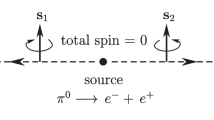Abstract
The role of SU(2) invariants for the classification of multiparty entanglement is discussed and exemplified for the Kempe invariant I 5 of pure three-qubit states. It is found being an independent invariant only in presence of both W-type entanglement and three-tangle. In this case, constant I 5 allows for a wide range of both three-tangle and concurrences. This means that I 5 provides no information on the entanglement in the system in addition to that contained already in the tangles (concurrences and three-tangle) themselves. Furthermore, norm-preserving SL ⊗3 orbits of states with equal tangles but continuously varying I 5 are shown to exist. As a consequence, I 5 can be increased (and decreased) by general local operations. Nevertheless, numerical analysis of random SLOCC’s has not shown any violation of the monotone property of I 5. In case I 5 finally turned out to being an entanglement monotone, this would imply that both SU(2) invariance and the stronger monotone property are too weak requirements for the characterization and quantification of entanglement for systems of three qubits, and that SL(2,ℂ) invariance is required. This conclusion can be extended to general multipartite systems (including higher local dimension) because the entanglement classes of three-qubit systems appear as subclasses.
Similar content being viewed by others
References
M.A. Nielsen, J. Kempe, Phys. Rev. Lett. 86, 5184 (2001)
K. Zyczkowski, I. Bengtsson, Ann. Phys. 195, 115 (2002)
G. Vidal, J. Mod. Opt. 47, 355 (2000)
C.H. Bennett, S. Popescu, D. Rohrlich, J.A. Smolin, A.V. Thapliyal, Phys. Rev. A 63, 012307 (2001)
A. Uhlmann, Phys. Rev. A 62, 032307 (2000)
S. Hill, W.K. Wootters, Phys. Rev. Lett. 78, 5022 (1997)
W.K. Wootters, Phys. Rev. Lett. 80, 2245 (1998)
F. Verstraete, J. Dehaene, B.D. Moor, Phys. Rev. A 68, 012103 (2003)
W. Dür, G. Vidal, J.I. Cirac, Phys. Rev. A 62, 062314 (2000)
V. Coffman, J. Kundu, W.K. Wootters, Phys. Rev. A 61, 052306 (2000)
S. Ishizaka, M.B. Plenio, Phys. Rev. A 72, 042325 (2005)
F. Verstraete, J. Dehaene, B. DeM̃oor, H. Verschelde, Phys. Rev. A 65, 052112 (2002)
J.-G. Luque, J.-Y. Thibon, Phys. Rev. A 67, 042303 (2003)
A. Miyake, Phys. Rev. A 67, 012108 (2003)
A. Osterloh, J. Siewert, Phys. Rev. A 72, 012337 (2005). arXiv:quant-ph/0410102
A. Osterloh, J. Siewert, Int. J. Quantum Inf. 4, 531 (2006). arXiv:quant-ph/0506073
J.-G. Luque, J.-Y. Thibon, J. Phys. A 39, 371 (2005)
O. Chterental, D.Ž. Đoković, Linear Algebra Research Advances (Nova Science, Hauppauge, 2007). arXiv:quant-ph/0612184
J.-G. Luque, J.-Y. Thibon, F. Toumazet, Math. Struct. Comput. Sci. 17, 1133 (2007)
D.Ž. Đoković, A. Osterloh, J. Math. Phys. 50, 033509 (2009)
P. Olver, Classical Invariant Theory (Cambridge University Press, Cambridge, 1999)
E. Briand, J.-G. Luque, J.-Y. Thibon, J. Phys. A 36, 9915 (2003)
A. Acín, A. Andrianov, L. Costa, E. Janè, J.I. Latorre, R. Tarrach, Phys. Rev. Lett. 85, 1560 (2000)
H.A. Carteret, A. Higushi, A. Sudbery, J. Math. Phys. 41, 7932 (2000)
A. Acín, A. Andrianov, E. Jane, R. Tarrach, J. Phys. A 34, 6725 (2001)
R.M. Gingrich, Phys. Rev. A 65, 052302 (2002)
A. Sudbery, J. Phys. A 34, 643 (2001)
J. Kempe, Phys. Rev. A 60, 910 (1999)
C.H. Bennett, S. Popescu, D. Rohrlich, J.A. Smolin, A.V. Thapliyal, Phys. Rev. A 63, 012307 (2001)
R. Lohmayer, A. Osterloh, J. Siewert, A. Uhlmann, Phys. Rev. Lett. 97, 260502 (2006)
C. Eltschka, A. Osterloh, J. Siewert, A. Uhlmann, New J. Phys. 10, 043014 (2008)
W.-L. Yang, J.-L. Chen, Phys. Rev. A 76, 034301 (2007)
Author information
Authors and Affiliations
Corresponding author
Rights and permissions
About this article
Cite this article
Osterloh, A. Classification of qubit entanglement: SL(2,ℂ) versus SU(2) invariance. Appl. Phys. B 98, 609–616 (2010). https://doi.org/10.1007/s00340-009-3859-3
Received:
Revised:
Published:
Issue Date:
DOI: https://doi.org/10.1007/s00340-009-3859-3




